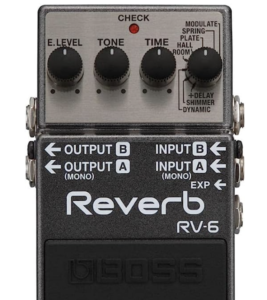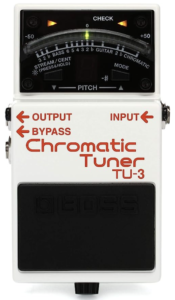The guitar has 6 strings that have standard notes. Although you can change tunning, most songs are played on a guitar with the standard tuning.
Standard Notes for Guitar Strings
 The list of guitar string notes is the following:
The list of guitar string notes is the following:
- 1st string: E
- 2nd string: B
- 3rd string: G
- 4th string: D
- 5th string: A
- 6th string: E
This standard tunning can change sometimes depending on the song. A few songs may require the 6th string tuned on D or even C.
The string notes follow a regular pattern of musical intervals:
- Between the 6th and 5th: a 4th interval (E and A).
- Then, between the 5th and 4th: a 4th interval (A and D).
- Between the 4th and 3th: a 4th interval (D and G).
- Then, between the 3th and 2th: a 3th interval (G and B).
- Between the 2th and 1th: a 4th interval (B and E).
Notice that the only interval that is different here is the between the 3rd and 2nd string (a 3rd instead of a forth).
To Get Correct Notes, You NEED a Chromatic Tuner!
Get a top chromatic tuner on Amazon!
Finding String Notes in the Guitar
 Starting from the notes that we have learned, it is possible to find even more about the string notes.
Starting from the notes that we have learned, it is possible to find even more about the string notes.
To understand this, you need to understand the distribution of steps between notes in the major scale.
If you take the C major scale (the white keys in the piano), you will have:
C, D, E, F, G, A, B
There is a half step between E and F. Also there is a half step between B and C. Between all other notes there is full step, which means that there is an intermediate note between them.
So, we have C#, D#, but not distinct E# (E# is the same as F).
Applying the Scale to the Guitar Strings
Knowning about the major scale will help you learn any note for any string in the guitar.
For example, starting from the 1st string, you will have the first not as E. Then, between E and F there is just half step. This means you have to move just one fret (each fret corresponds to a half step).
Then, to get from F to G, you need a whole step. This means you need to move two frets to reach the G note (two frets correspond to a whole step).
Following this procedure, you will find all other notes in the first string. Two frets from G you will have A. Then two more frets and you’ll have B. Then, moving a single fret you’ll have C.
The same procedure can be applied to other strings. For example, see this diagram with all notes in the first 5 frets of the guitar.

What are the notes on guitar?
On a standard-tuned guitar, the notes are typically arranged as follows:
Open strings (from thickest to thinnest string):
- E (6th string)
- A (5th string)
- D (4th string)
- G (3rd string)
- B (2nd string)
- E (1st string)
As you move up the neck, the notes on each string follow a chromatic scale, meaning they ascend by one semitone (or half step) with each fret. Here’s a breakdown of the notes on the 6th (thickest) string as you move up the neck:
- 1st fret: F
- 2nd fret: F#/Gb
- 3rd fret: G
- 4th fret: G#/Ab
- 5th fret: A
- 6th fret: A#/Bb
- 7th fret: B
- 8th fret: C
- 9th fret: C#/Db
- 10th fret: D
- 11th fret: D#/Eb
- 12th fret: E (one octave higher than the open string)
This pattern repeats as you move further up the neck, allowing you to play the same notes in higher octaves.
It’s worth noting that these notes are based on standard tuning (EADGBE), and alternative tunings can result in different note arrangements. Additionally, there are more than one way to play the same note on different strings and frets, providing guitarists with various options for playing melodies, chords, and scales across the instrument.
Finding all C notes on a guitar
To find all the C notes on a guitar, you can use a combination of open strings and fret positions. Here’s a breakdown of the C notes on each string:
- 6th string (thickest string):
- 8th fret: C
- 5th string:
- 3rd fret: C
- 4th string:
- 10th fret: C
- 3rd string:
- 5th fret: C
- 2nd string:
- 1st fret: C
- 13th fret: C
- 1st string (thinnest string):
- 8th fret: C
By playing these fret positions on each string, you will find all the C notes on the guitar. Keep in mind that these are just the most common positions, and there are other locations on the fretboard where you can find C notes as well. As you become more familiar with the guitar, you’ll discover additional ways to play the same note in different positions and octaves.
How to find f notes on guitar?
To find F notes on the guitar, you can use a combination of open strings and fret positions. Here’s a breakdown of the F notes on each string:
- 6th string (thickest string):
- 1st fret: F
- 5th string:
- 8th fret: F
- 4th string:
- 3rd fret: F
- 15th fret: F
- 3rd string:
- 10th fret: F
- 2nd string:
- 6th fret: F
- 1st string (thinnest string):
- 1st fret: F
- 13th fret: F
By playing these fret positions on each string, you will find all the F notes on the guitar. Keep in mind that these are just the most common positions, and there are other locations on the fretboard where you can find F notes as well.
Learn More About the Guitar
If you want to learn to play the guitar, we have free lessons on our exclusive PDF course. Just request your guitar course and it will be sent by email. The course cover the following topics:
- Finding guitar notes
- Learning guitar chords
- Playing simple songs
- Learning guitar tablature
- Lots of exercises
- And much more.
Click here to get now your guitar course.
